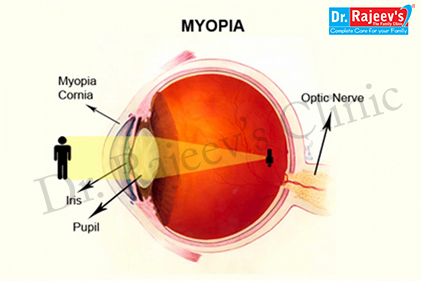

Myopia is known as nearsightedness in common parlance. People suffering from myopia can see near objects clearly and have a problem viewing distant objects which appear blurred and with less clarity.Myopia has high prevalence in Asian countries up to 80-90% as compared to 30-40% in European countries and the United States, and 10-20% in Africa. Research has proved a relationship between myopia and high IQ.Combination of genetic predisposition and environmental factors like near sighted work like reading, computer games, watching TV is one of the reasons for myopia.
Nearsightedness symptoms may include:
Blurry vision when looking at distant objects
The need to squint or partially close the eyelids to see clearly
Headaches caused by eyestrain
Nearsightedness is often first detected during childhood and is commonly diagnosed between the early school years through the teens. A child with nearsightedness may:
Eye has two parts that focus images:
In a normally shaped eye, each of these focusing elements has a perfectly smooth curvature, like the surface of a marble. A cornea and lens with such curvature bend (refract) all incoming light to make a sharply focused image directly on the retina, at the back of your eye.
If your cornea or lens isn't evenly and smoothly curved, light rays aren't refracted properly, and you have a refractive error.
Nearsightedness usually occurs when your eyeball is longer than normal or your cornea is curved too steeply. Instead of being focused precisely on your retina, light is focused in front of your retina, resulting in a blurry appearance for distant objects.
In addition to nearsightedness, other refractive errors include:
Certain risk factors may increase the likelihood of developing nearsightedness, such as:
Pysostigma is one of the most remarkable and often prescribed medicines for myopia. Pysostigma is well indicated for nearsightedness which is progressing rapidly, accompanied by pain in the orbits. The person experiences photophobia along with blurred vision. Spasm of the ciliary muscle, irritability of the eyes and dim vision are treated best with Pysostigma.
Ruta is one the most suitable medicines for myopia with a severe headache. The person experiences pain while reading, sewing and performing other near-sighted activities. Weakness of the ciliary muscles and blurred vision are the signs to look out for prescription of Ruta, rated among the best medicines for myopia. Ruta acts very well for eyestrain occurring from overuse of eyes.
Another of the useful medicine for myopia is Viola Odorata. Myopia, where it is accompanied by severe pain in the eyes, is treated most effectively with Viola Odorata. In such cases, the person complains of severe pain in the eyes which radiates to the top of the head (vertex). Heaviness of the eyelids, flames before the eyes and nearsightedness are other symptoms that merit use of Viola Odorata as the ideal prescription among medicines for myopia.
Oleum Animale is one of the most wonderful medicines for myopia where the symptoms include blurred vision with smarting in the eyes. The person often sees glistening bodies before his eyes and complains of dim vision. Nearsightedness accompanied by twitching of the eyelids is also treated well with Oleum Animale.
Phosphorus is one of the most highly recommended medicines for myopia. Fatigue of the eyes and head even when the eyes are not being overused is a key symptom for prescription of Phosphorus. It is one of the best-indicated medicines for myopia with weak eyesight and an aversion to light. A feeling of having sand in the eyes which gets better by rubbing may also be present. Frequent itching in the eyes with profuse lachrymation is also present. Nearsightedness with atrophy of optic nerve is treated well with medicine Phosphorus as well.
RL46